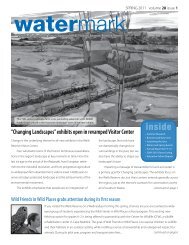Management Plan - National Estuarine Research Reserve System
Management Plan - National Estuarine Research Reserve System
Management Plan - National Estuarine Research Reserve System
You also want an ePaper? Increase the reach of your titles
YUMPU automatically turns print PDFs into web optimized ePapers that Google loves.
The following paragraphs specifically address partsof 15 C.F.R. sec. 921.11 that apply to delineating<strong>Reserve</strong> boundary.EcologySection 921.11(c)(3) requires “...assurances that theSite’s boundaries encompass an adequate portionof key land and water areas of the natural systemto approximate an ecological unit to ensure effectiveconservation.” The proposed boundary willprovide these heightened assurances by helping tomaintain the integrity of coastal watersheds, andprotecting water quality and habitat diversity. TheWells <strong>Reserve</strong> works with organizations, agencies,and communities to identify and conserve criticalresources whose destruction or degradation coulddiminish the <strong>Reserve</strong>’s estuarine resources.Maintain the Integrity of CoastalWatershedsCoastal land use patterns in southern Maine arechanging from rural forest and farmland to suburbansprawl. Development is fragmenting habitat,affecting wetlands, and degrading water qualityand aquatic habitats. These alterations directly andindirectly affect coastal resources and estuarinedependentspecies.Coastal communities, which already have theregion’s densest populations in the region, are experiencinghigh rates of growth. Vacant oceanfrontproperty no longer exists in Wells. Building lotsalong the salt marsh edge are rare and expensive.Development pressure now falls on upland acreage,particularly along the banks of coastal rivers andstreams. Newly developed areas tend to have largeareas of natural vegetation replaced by impervioussurfaces, intensively managed lawns, and nonnativeplant species.Without conservation efforts, including educationand research, land along the major watercoursesflowing through the Wells <strong>Reserve</strong> will continue tobe lost or negatively impacted by development. The<strong>Reserve</strong> could gradually become a biological island— a protected place surrounded by human development,disconnected from other thriving naturalareas with consequent ecosystem imbalances andresource deterioration.Protecting Water QualityThe economies of southern Maine communitiesdepend heavily on visitors who are attracted to thearea’s extensive fine sandy beaches with their clean,swimmable water. Wells and surrounding communitiesalso obtain drinking water from local rivers.Residents and visitors derive work, sustenance, andrecreation from local fish and shellfish.Toxic contaminants that settle onto roads, parkinglots, and other impervious surfaces are carriedto estuaries in stormwater. Pathogens, nutrients,and toxins from faulty septic systems, pet waste,landscaping, and overtaxed wastewater treatmentfacilities also diminish water quality.To a significant extent, the quality of water andaquatic habitats in the tributaries and estuariesof the <strong>Reserve</strong> depends upon upland forests andwetlands, which filter sediments and pollutants,provide shade, reduce erosion and channelization,and support the food web. Protecting forestedriparian zones is critical for assuring high waterquality throughout watersheds.State and local land-use ordinances cannot preventthe degradation of water quality over the long term.Conserving riparian and aquatic buffers is the mosteffective, and lasting, method of protection.Habitat ProtectionThe Webhannet River and the Little River watershedssupport the plant and animal species thatuse riparian lands exclusively and those that relyon rivers for breeding habitat and travel corridors.Over the years, other organizations (Rachel CarsonNWR, Wells Conservation Commission, GreatWorks Regional Land Trust, Wells/Kennebunk/Kennebunkport Water District) have protectedmore than 3,300 acres of land in these watersheds.102 Wells <strong>National</strong> <strong>Estuarine</strong> <strong>Research</strong> <strong>Reserve</strong>




